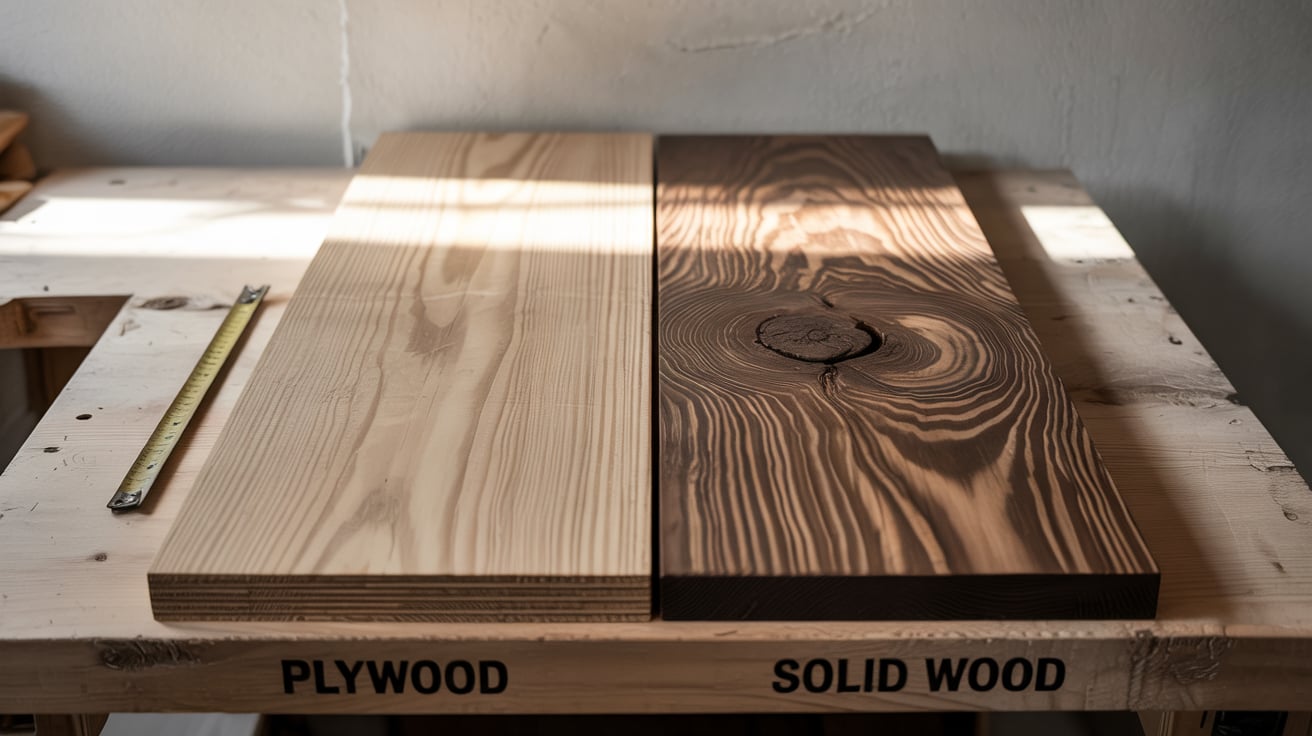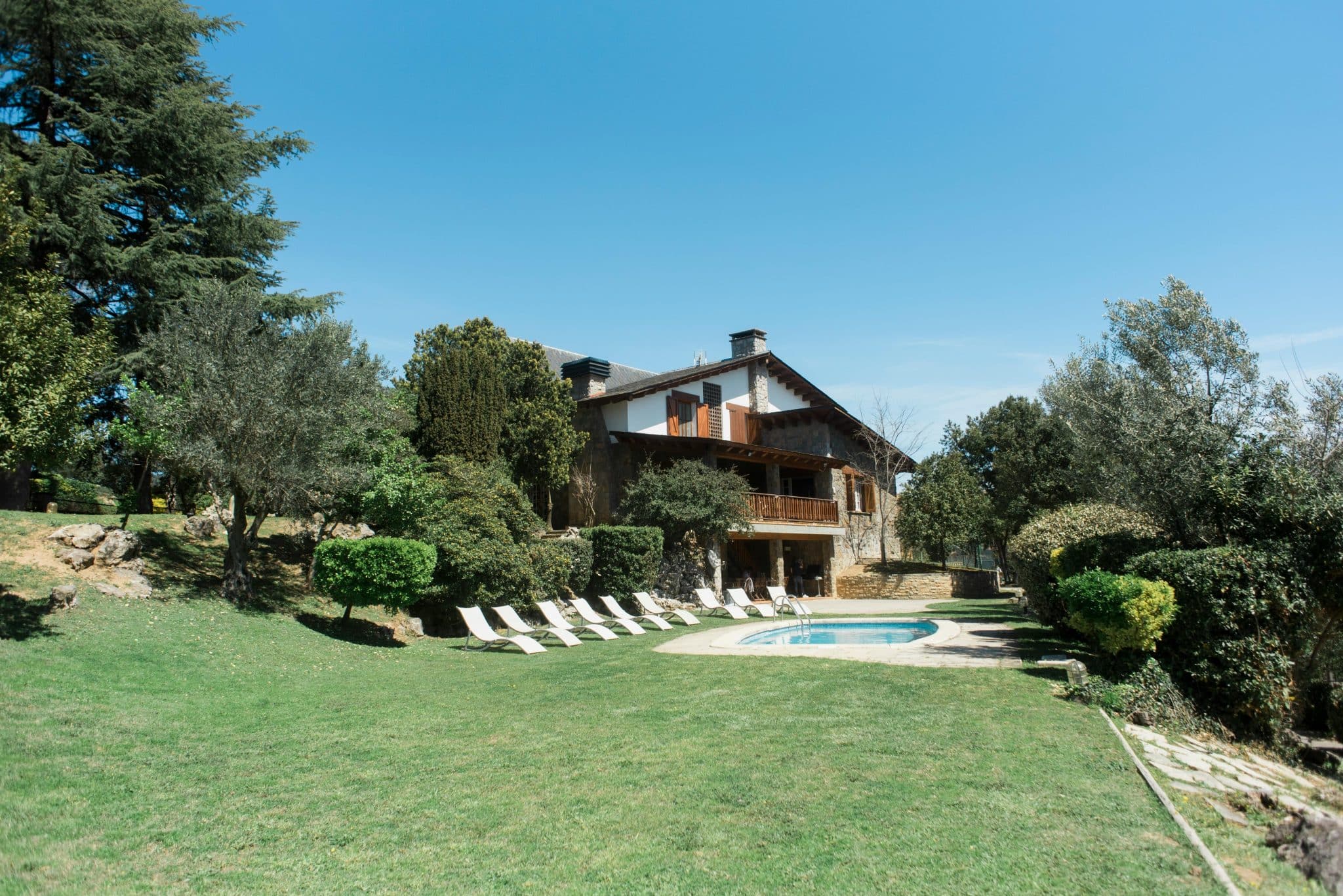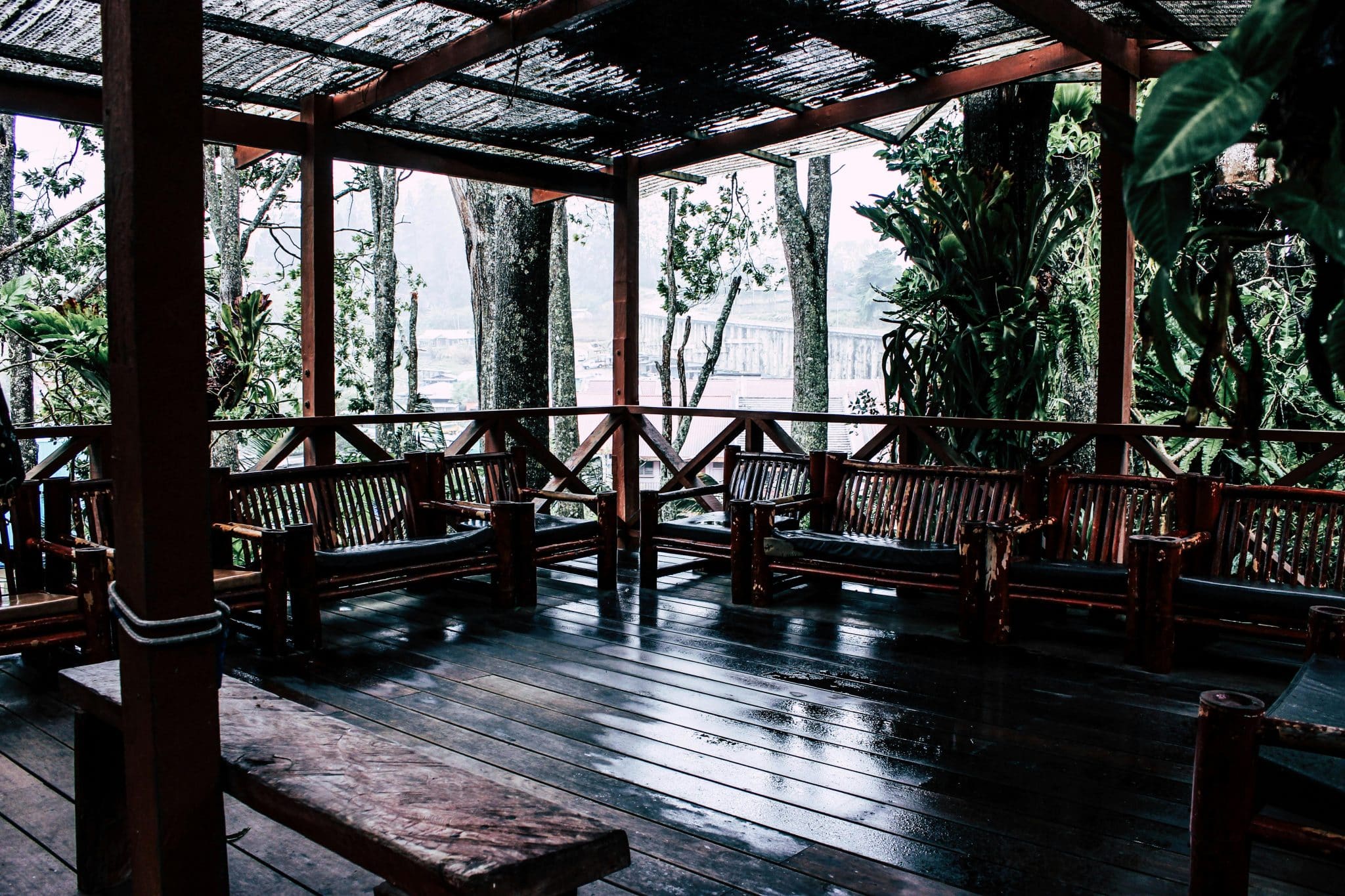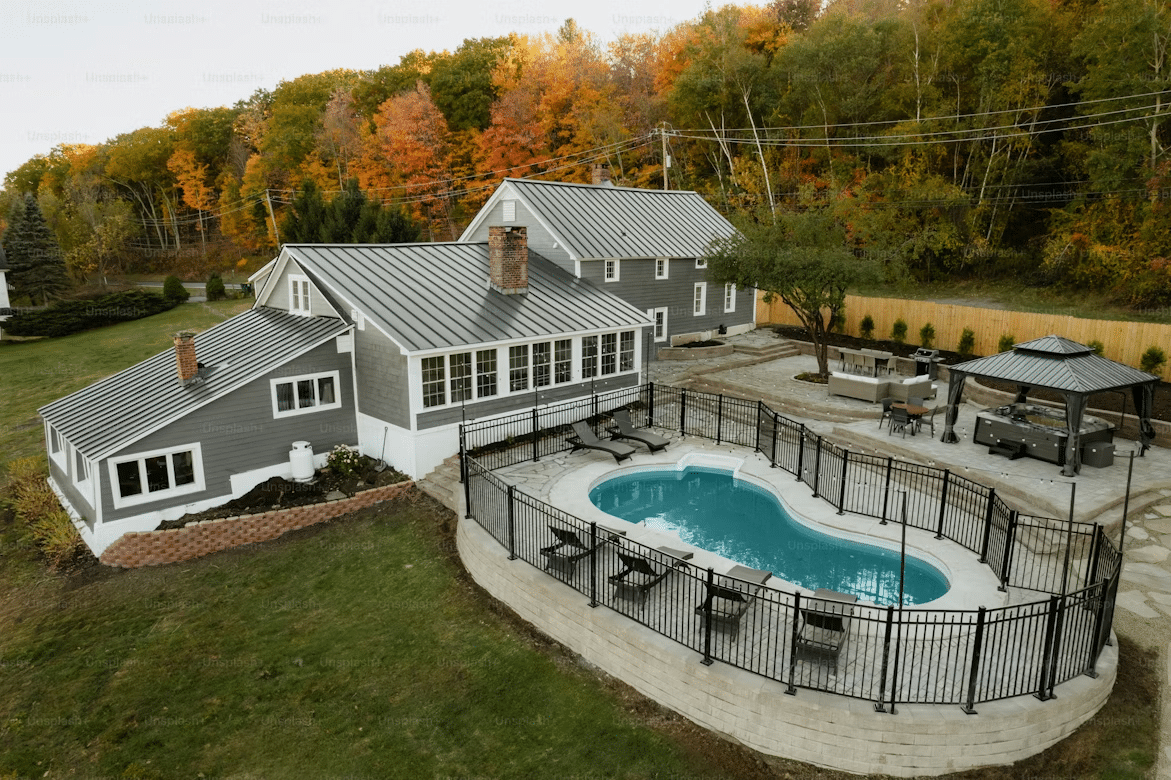Choosing between plywood and solid wood can be confusing when starting a woodworking project.
Many DIY builders and home renovators face this common dilemma: unsure which material offers the best value and results.
I’m here to help you make this choice simpler. In this post, I’ll explain the key differences between these two popular materials so you can choose the right one for your specific needs and budget.
This article compares plywood and solid wood based on several factors, including strength, cost, appearance, and environmental impact.
I’ll also outline when to use each material and share tips for making the best choice for furniture projects.
Major Contrasts Between Plywood and Solid Wood
| Feature | Plywood | Solid Wood |
|---|---|---|
| Strength and Durability | Based on grade quality, it can be strong. It is more stable in changing conditions but may wear faster over time. It is also less prone to splitting. | Offers high natural strength. Very durable when well-maintained. It may expand or contract with humidity changes. |
| Cost Comparison | More budget-friendly. Better for large-scale projects where costs add up quickly. | It costs more than plywood, and the price varies by wood type (pine vs. oak, etc.). However, it is worth the cost for certain projects. |
| Aesthetic Considerations | It requires extra finishing for a polished look. The edges need treatment to look finished. A wide range of veneer options is available. | It shows natural wood grain and texture and has a warm, authentic look. It ages well and can develop character over time. |
| Environmental Impact | Uses smaller wood pieces efficiently. Less waste in production. Look for FSC-certified options for better eco-value. | It uses larger sections of trees. Some types come from slow-growing trees. If from well-managed forests, it can be sustainable. |
Solid wood boasts excellent strength from its natural structure. A good oak table can last for many years or even pass down through family members.
That said, plywood with a high-grade rating can work well for many building needs and often resists warping better in damp settings.
The cost factor plays a big role in many project choices. Plywood tends to cost less for the same area coverage, which makes it an ideal pick for bigger jobs like home walls or floor bases.
Solid wood costs more but brings value through its long life and repair options.
What Is Plywood?
Plywood is an engineered wood made by gluing thin sheets of wood veneer together. The wood grain of each layer is placed at right angles to the one above it, creating a cross-layered structure for added strength.
Plywood typically has an odd number of layers (3, 5, or 7) to ensure balance and prevent warping. The outer layers, known as “face veneers,” are usually of higher quality than the inner core.
Types of Plywood
Several types of plywood exist for different uses:
- Softwood Plywood: Made from pine, fir, or cedar. It costs less but may not look as nice as other types. It works well for basic building needs like wall panels and roof bases.
- Hardwood Plywood: Uses outer layers of woods like oak, maple, or birch. This type looks better and costs more. People choose it for furniture and cabinets.
- Marine Plywood: Made with special glues that stand up to water. Boat builders use this type, as do outdoor project makers.
- CDX Plywood: A building grade meant for places that might get wet but will later dry out, like roof parts.
- MDF Core Plywood: Has inner layers made of medium-density fiberboard with wood veneer faces. This type gives very smooth, flat results.
Common Uses of Plywood
- Construction: Builders use plywood for walls, floors, and roofs due to its strength and stability over large, flat areas.
- Furniture: Furniture makers use plywood for panels like cabinet sides, backs, and shelves, as its cross-grain pattern prevents warping.
- Concrete Forms: Plywood is ideal for creating molds for wet concrete, providing strong support while it dries.
- Flooring Base: Plywood provides a flat, even surface for flooring materials like vinyl or laminate.
- Outdoor Projects: Treated plywood is commonly used for outdoor builds, such as sheds and fences, as it withstands rain and snow better than some other woods.
When to Choose Plywood?
Plywood shines in many building situations where budget matters. It works well for:
- Structural needs: Wall panels, subfloors, and roof sheathing hold up well with plywood.
- Large flat surfaces: Kitchen cabinets, bookcases, and built-in storage units benefit from plywood’s stability.
- Hidden elements: Cabinet backs, drawer bottoms, and other non-visible parts make sense in plywood.
- Curved designs: Thin plywood can bend to create curved forms that solid wood cannot match.
- Painted projects: When you plan to paint the final product, the wood grain won’t show anyway.
Plywood is a good choice when you need to cover large areas without spending a lot. Its flat, stable sheets cut down on construction time.
For a home office desk or kids’ playroom storage, plywood offers good value with proper edge finishing.
What Is Solid Wood?
Solid wood comes straight from tree trunks. Lumber mills cut logs into boards of different sizes. Unlike plywood, solid wood has no layers or glue; it’s just the natural wood as it grew in the tree.
The grain pattern runs through the full thickness of each board. Solid wood keeps all its natural traits, such as knots, color shifts, and grain patterns that show the tree’s growth history. These marks give each piece its unique look.
Types of Solid Wood
Hardwoods: Come from deciduous trees (those that lose leaves in winter).
- Oak: Strong with distinct grain patterns, durable, and takes stain well.
- Maple: Light in color with subtle grain, hard, and perfect for high-traffic floors and furniture.
- Cherry: Starts reddish-brown and darkens with age; smooth grain, ideal for fine furniture.
- Walnut: Dark brown with purple hues, known for its rich appearance in high-end pieces.
Softwoods: Come from cone-bearing trees.
- Pine: Affordable, soft, light-colored, and beginner-friendly.
- Cedar: Naturally repels bugs and rot, used for outdoor projects.
- Fir: Strong and cost-effective, commonly used for framing and trim.
- Redwood: Naturally resistant to rot, great for decks and outdoor furniture.
Common Uses of Solid Wood
- Fine Furniture: Solid wood is preferred for dining tables, chairs, and bed frames due to its beauty and durability, justifying the higher cost.
- Flooring: Wood floors are valued for their warmth, longevity, and the ability to be sanded and repaired when worn.
- Kitchen Items: Solid wood is commonly used for cutting boards and utensils, with maple and walnut being popular for their durability and food safety.
- Musical Instruments: Instruments like guitars and pianos require solid wood for its sound quality, with each wood type producing a unique tone.
- Trim Work: Solid wood is used for trim around doors, windows, and floors, maintaining a sharp, clean look for years.
When to Choose Solid Wood?
Solid wood stands out as the best choice when:
- Quality matters most: Dining tables, bed frames, and special furniture pieces deserve solid wood’s beauty.
- You want lasting value: Items meant to last for years or pass down to family members.
- The wood itself is the feature: the natural grain pattern should stand out.
- Repair might be needed: Solid wood can be sanded and fixed more times than plywood.
- Heavy use is expected: Solid wood handles daily wear better in many cases.
For your living room coffee table or a special bookshelf, solid wood brings a quality that guests notice. The slight extra cost pays off in how long these items last and how well they hold up to daily life.
The right choice depends on what you’re making, where it will go, and how long you want it to last.
Many skilled woodworkers mix both materials, using solid wood for visible parts and plywood for the inner structure, to get the best of both worlds.
Understanding the Lifespan of Plywood vs. Solid Wood
Solid Wood Longevity
With proper care, solid wood can last for decades or even centuries. High-quality hardwoods like oak and maple outlast softer woods like pine.
Solid wood’s ability to be refinished multiple times enhances its lifespan. However, moisture changes, water damage, and insect problems can shorten its durability.
Plywood’s Lifespan
Plywood typically lasts 20-40 years, depending on quality. Higher-grade plywood with more layers lasts longer, but glue between layers can deteriorate over time, especially with moisture exposure.
Plywood edges are vulnerable to water damage. Indoor plywood lasts longer than outdoor plywood unless treated.
Pros and Cons of Plywood vs. Solid Wood
Pros and Cons of Plywood
| Pros of Plywood | Cons of Plywood |
|---|---|
| Cost-effective: Less expensive than solid wood for similar sizes. | Less durability: It can degrade over time if exposed to moisture. |
| Lightweight: Easier to move and work with. | Edge appearance: Layers show, requiring edge banding for a clean look. |
| Stable in different conditions: Less prone to warping and cracking. | Surface limits: It cannot be sanded too much without damaging the surface. |
| Consistent strength: Even strength across the sheet due to cross-grain layers. | Repair challenges: Difficult to fix deep scratches or dents. |
| Wide sheets available: Suitable for large flat surfaces without seams. | Chemical concerns: Some plywood uses glues that release gases. |
Pros and Cons of Solid Wood
| Pros of Solid Wood | Cons of Solid Wood |
|---|---|
| Long-lasting: Can last for generations with proper care. | Higher cost: More expensive than plywood, especially for premium wood. |
| Natural beauty: Unique, warm grain patterns for an attractive look. | Changes with humidity: Expands and contracts, possibly causing cracks. |
| Can be refinished: Easily sanded and refinished multiple times. | Heavier weight: More difficult to move and may need stronger supports. |
| Ages well: Gains character and patina as it matures. | Size limits: Limited by the size of trees for board width. |
| Strong joints: Allows for strong joinery methods that enhance durability. | Needs care: Requires maintenance like cleaning, oiling, or polishing. |
Conclusion
Choosing between plywood and solid wood depends on your needs, budget, and project goals. Both have their place in woodworking and construction.
Plywood offers good value when you need flat, stable panels that resist warping.
Its strength and lower cost make it ideal for large surfaces and projects where the wood is not highly visible.
Solid wood brings natural beauty and lasting quality that many find worth the higher price.
Its ability to be refinished and repaired extends the life of furniture and other items you’ll use daily.
Many skilled builders combine both materials, using solid wood for visible parts and plywood for hidden structural elements.
This smart approach gives you the best of both worlds: beauty where it matters and cost savings where it doesn’t.
Frequently Asked Questions
1. Which Is Better, Solid Wood or Plywood?
It depends on your needs. Solid wood offers beauty and durability, while plywood provides better stability and resistance to warping.
2. Why Do People Use Plywood?
Plywood is used for its stability, strength, availability in large sheets, resistance to warping, and cost-effectiveness.
3. Can I Use Plywood on Interior Walls?
Yes, plywood works well for interior walls. It offers good structural support, easy installation, and a surface for paint or other finishes.











One Comment
vavada casino: vavada вход – вавада зеркало